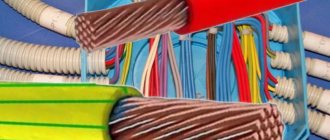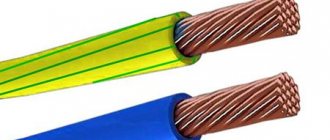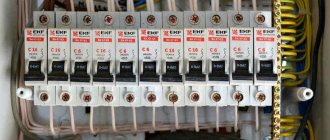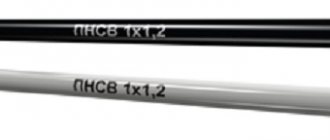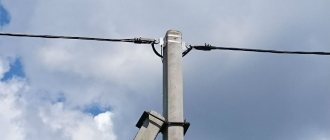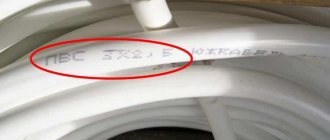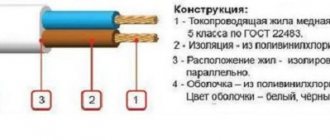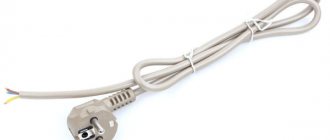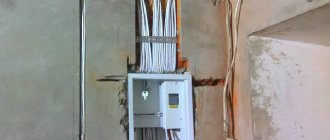PuGV wire is a power conductor with copper conductors. Most often it is insulated with polyvinyl chloride and does not have a shell. It can be used both in the implementation of building wiring and for laying power cable lines.
The cable cores consist of a group of tinned copper rods. The number of rods varies depending on the type and manufacturer, but is usually at least seven. Such cables are used in closed premises to supply stationary devices with electricity. Laying outdoors is allowed, provided there is protection from direct sunlight and precipitation (canopies and similar devices are used for this).
Application area
In lighting networks, power lines. Widely used in rooms of varying degrees of humidity - normal, damp, especially damp, with the presence of steam emissions of acids and alkalis. If the ambient temperature does not exceed 40 degrees Celsius, then it can be used to connect launch boxes, light panels, closed cabinets.
Multiple bends of the wire are allowed. This wire replaced the wires PV1, PV3, PV4.
Multifunctional wire PuGV is used for electrical installations for stationary installation in networks of various directions (lighting, power networks), installation of electrical equipment, devices, mechanisms and machines with alternating voltage up to 750 V, or direct voltage up to 1000 V.
PuGV wire load currents
Permissible load currents for wires are not regulated in GOST. In accordance with the PUE, for any installation method it is recommended that for single wires not exceed the load currents indicated in the table.
| Nominal conductor cross-section, mm2 | Permissible load current, A |
| 0,75 | 15 |
| 1,0 | 17 |
| 1,5 | 23 |
| 2,5 | 30 |
| 4 | 41 |
| 6 | 50 |
| 10 | 80 |
| 16 | 100 |
| 25 | 140 |
| 35 | 170 |
| 50 | 215 |
Explanation of the name
Explanation of the abbreviation PuGV:
- P - wire;
- U - installation;
- G - flexible;
- B - with polyvinyl chloride insulation.
PuGV performs a connecting function for electrical installations; it has one core, the cross-sectional area of which is determined depending on the standard size. The core flexibility of conductors of this type can be of three classes: 3, 4 or 5 according to GOST standards. The cable can be used in moderate and cold climates (UHL, from +40 to –60 °C) and more severe conditions.
Weight and size parameters of PuGV wire
Approximate weights of the most common wire cross-sections for packaging and transportation purposes are given in the table. The given values may differ for wires of different batches and manufacturers by 10% less or more.
| Section | Weight value for packaging and transportation purposes, kg/km |
| 0,75 | 12 |
| 1,0 | 14 |
| 1,5 | 20 |
| 2,5 | 31 |
| 4 | 48 |
| 6 | 70 |
| 10 | 116 |
| 16 | 182 |
| 25 | 287 |
| 35 | 378 |
| 50 | 520 |
Benefits and Features
Increased flexibility allows you to lay the cable in a box and all kinds of pipes. You can lay lines with a variety of bends and turns. If the wiring does not involve the presence of other types of electrical wires, then the likelihood of a fire is minimized. With proper operation, the service life of such a line can be twenty or more years. The service life should be calculated from the date of manufacture.
Supplied without additional protective layers and shell, since PVC is not afraid of light, water and mechanical damage (within reasonable limits).
Labeling requirements
Wires must have the manufacturer's designation and the wire identification, which must be made in the form of a continuous marking on the insulation surface. The marking may be printed, embossed or stamped onto the surface of the wire. The distance from the end of the marking to the beginning of the next one should not exceed 500 mm. It is allowed to mark wires with a cross-section of up to 6 mm2 in the form of a distinctive thread or colored stripes or solid marks.
The label attached to the coil or drum, or on the cheek of the drum, must indicate:
— trademark of the manufacturer; — symbol of the wire (full, indicating the number of cores and cross-section); — length in meters; — gross weight (for drums) in kilograms — date of manufacture (year, month); — GOST designation.
The label must bear a technical control stamp and a certification mark.
For wires supplied on a drum, the label attached to the coil or drum, or on the cheek of the drum, must indicate the number of sections and their length through a plus sign from the top to the bottom layers in meters.
Design Features
It consists of a core that passes electric current and PVC insulation. Flexibility is achieved due to the fact that each current-carrying core consists of several copper wires, which are connected by twisting. Sections from 0.5 mm² to 35 mm² consist of 7 or more wires twisted together.
The flexibility of an electrical wire is inversely proportional to the cross-sectional area: the larger the area, the less flexible the cable. Also, flexibility depends on the diameter of the individual wires located inside; the larger their diameter, the lower the flexibility index.
Sectional view of electrical wire
Where is PuGV used?
PuGV wires belong to multifunctional cable products, and therefore have a wide range of applications. It's all about the cross-section, the minimum diameter of which can be 0.5 mm², and the maximum - 400 mm². Based on these parameters, you can create both switching and power lines.
Important! When installing in open areas, it is necessary to use protective structures. These can be special trays or boxes. You can also use any type of pipe. The main task here is to prevent direct exposure of ultraviolet radiation to the insulation. Let us remind you that the sun's rays have a destructive effect on polyvinyl chloride material.
PuGV wire is the most popular in everyday life. It is suitable for equipping electrical wiring in rooms under protective or decorative materials. It can be hidden inside a stretch or suspended ceiling, or placed under plaster. It is often used to install a network inside brickwork or monolithic concrete. All this became possible thanks to the presence of wire insulation.
Insulation
The thickness of the insulation depends on the cross-section. It is possible to use two-layer insulation, but in this case the first layer must be 70 percent of the total insulation thickness or more. Colors are determined depending on the customer’s needs, or standard colors are used.
PVC insulation
Polyvinyl chloride insulation significantly increases the service life of wiring due to its chemical properties. It decomposes slowly, is not afraid of moisture, extreme temperatures and corrosion, and also has a significant margin of safety that does not allow rodents to chew through the wiring. In addition, it has a special smell that repels rats and mice.
It is worth emphasizing that PVC cables with double-layer insulation are safer. The double layer reduces heating from current, reduces the likelihood of fire and increases resistance to high temperatures in general. Therefore, PVC electrical wires are often used in high-voltage lines.
Analogs and best manufacturers
PuGV is a complete modern analogue of classic PV wires, while PuV is similar to PV-1, since it has class 1 flexibility and similar characteristics, and instead of PuGV they use PV-3 or PV-4.
Most domestic manufacturers produce installation wires of good quality, however, among them the following leaders can be distinguished:
- Kavkazcable;
- Energy cable;
- Kamkabel.
This concludes the description of the characteristics of the PuGV wire. Now you know what this wire consists of, where it is used and what it is needed for. We hope the information provided was useful to you!
Specifications
Flexibility is an important feature of this type of cable; the bending radius is measured in outer diameters. Thus, the bending radius of the PuGV is ten or more diameters.
Other mechanical characteristics:
- operating temperatures - from –50 to +65 degrees Celsius, installation should be carried out in much less severe conditions, approximately from –15 to +30 degrees;
- able to withstand significant mechanical damage and shock;
- the weight of the wire is calculated depending on the cross-section or diameter, as shown in the table below;
- service life - fifteen years.
This type of wiring can withstand 450 to 750 volts of alternating current having a frequency of 400 Hz or 1000 volts of direct current. Withstands environmental humidity up to 98%.
Important! PuGV wire (especially PuGVng-LS) is often used in places with high temperature loads - baths and the like; it is considered safer because it does not burn. Special insulation protects the cable from fire, so in the event of a fire it only melts. The insulating shell can withstand temperatures of +160 degrees Celsius. Thanks to this, PuGVng LS is used as leads for electric motors and for charging lighting devices with temperatures from +80 to +180 degrees.
Purpose
In cases where space is limited, but it is necessary to make high-quality installation of electrical equipment, flexible PuGV is used, and also if power wires energized up to 450 V are supposed to be bent frequently. For example, objects that have vibration or some movement are connected, wires collected in bundles and tied with a thread (they can be bent during operation). They can be placed in sleeves, attached to a cable and moved along it.
PuGV is used in enclosed spaces to connect various devices and units. It is allowed to be installed in walls under plaster. External use is allowed, but under a canopy, with mandatory protection from ultraviolet rays. Do not expose the wire to moisture from precipitation. Since stranded wire has a large surface area, contact with moisture results in rapid oxidation. Solid rod is less susceptible to corrosion. To prevent this drawback, tinned wires are used.
Wire flexibility category
Check upon purchase
It is recommended to check the PV-3 cable very carefully before purchasing, since the market is flooded with a large number of fakes, characterized at best by an undersized cross-section, and at worst by a complete non-compliance with the stated requirements, primarily in terms of safety.
- It is always recommended to take products that are labeled with the wording GOST, and not TU. A cable made according to specifications is not formally considered a fake, but the fact is that each manufacturer determines the “technical conditions” for himself.
- A label should always be stuck on the bay, and alphanumeric markings should be applied to the insulation in a certain increment (about half a meter).
- Check the cross-section with a caliper you take with you.
- Request from the seller documents that the wire has passed the conductor resistance test, the insulation breakdown test, and the voltage test.
In addition, periodically during operation the cable must undergo “running tests”.
What does the abbreviation PUV/PUGV mean?
On price tags, in price lists or on the protective shell, alphabetic and numerical markings are indicated. Its decoding for the PUV wire is the essence of the application. So, the first digit indicates the number of cores (from 1 to 3), in PUGV it is always “monolith”, but the parameter is still indicated. The second indicates the cross section in mm2. It remains to understand the abbreviation.
Explanation:
- P - category “wire” (single cores are often used);
- U - “installation” purpose;
- B - polyvinyl chloride shell.
The second letter “B” (PUVV, PUGVV) means that the products are supplied in double insulation. Both are made from PVC plastic. Special attention should be paid to “G” in the decoding of the PUGV wire, which determines the scope of application. She points to its main property - “flexible”. This brand is supplied only multi-wire (as opposed to a single PUV core). Explanations are given in GOST 22483-2012, which discusses standards for flexibility classes.
